Papers by Vinayak N Kulkarni
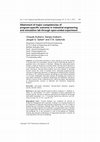
Int. J. Continuing Engineering Education and Life-Long Learning, 2017
An open-ended experiment is where students are given the freedom
to develop their own experiments... more An open-ended experiment is where students are given the freedom
to develop their own experiments, instead of merely following the already set guidelines from a lab manual or elsewhere. Making labs open-ended pushes students to think for themselves and think harder. Outcome-based education is an educational theory that bases each part of an educational system around goals (outcomes). Outcome-based methods have been adopted in education systems around the world, at multiple levels. Measuring program-specific outcomes in engineering education is a challenge for teaching faculty in general and doing so for a laboratory program and through an open-ended experiment is even more challenging. This paper explains the planning and execution of open-ended experiment in Industrial Engineering and Simulation Laboratory and also it focuses on the evaluation process, rubrics developed, and attainment of program-specific outcome in Industrial and Production Engineering Program.
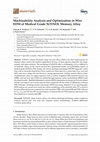
Materials MDPI, 2020
NiTiNOL (Nickel-Titanium) shape memory alloys (SMAs) are ideal replacements for titanium alloys u... more NiTiNOL (Nickel-Titanium) shape memory alloys (SMAs) are ideal replacements for titanium alloys used in bio-medical applications because of their superior properties like shape memory and super elasticity. The machining of NiTiNOL alloy is challenging, as it is a difficult to cut material. Hence, in the current research the experimental studies on machinability aspects of medical grade NiTiNOL SMA during wire electric discharge machining (WEDM) using zinc coated brass wire as electrode material have been carried out. Pulse time (T on), pause time (T off), wire feed (WF), and servo voltage (SV) are chosen as varying input process variables and the effects of their combinational values on output responses such as surface roughness (SR), material removal rate (MRR), and tool wear rate (TWR) are studied through response surface methodology (RSM) based developed models. Modified differential evolution (MDE) optimization technique has been developed and the convergence curve of the same has been compared with the results of differential evolution (DE) technique. Scanning electron microscopy (SEM) and energy dispersive X-ray spectrography (EDS) analysis are carried out to study the surface morphology of the machined alloy. SV is found to be more influential process parameter for achieving better MRR with minimal SR and TWR, followed by T on , T off , and WF. The WF has good impact on reduced SR and TWR responses and found to be least significant in maximizing MRR.
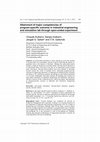
International Journal of Continuing Engineering Education and Life Long Learning ; Inderscience Publishers Ltd, 2017
An open-ended experiment is where students are given the freedom to develop their own experiments... more An open-ended experiment is where students are given the freedom to develop their own experiments, instead of merely following the already set guidelines from a lab manual or elsewhere. Making labs open-ended pushes students to think for themselves and think harder. Outcome-based education is an educational theory that bases each part of an educational system around goals (outcomes). Outcome-based methods have been adopted in education systems around the world, at multiple levels. Measuring program-specific outcomes in engineering education is a challenge for teaching faculty in general and doing so for a laboratory program and through an open-ended experiment is even more challenging. This paper explains the planning and execution of open-ended experiment in Industrial Engineering and Simulation Laboratory and also it focuses on the evaluation process, rubrics developed, and attainment of program-specific outcome in Industrial and Production Engineering Program.
Materials today: proceedings, Elsevier, 2018
Nickel-Titanium (NiTi) alloys are difficult to machine materials because of their superelastic an... more Nickel-Titanium (NiTi) alloys are difficult to machine materials because of their superelastic and shape memory properties. The present work focuses on study of effects of different input parameters of wire electric discharge machining on output responses like surface roughness and material removal rate during machining of NiTi alloys. The various concepts of design of experiments have been used for planning the experiments, developing the models and for investigating the influence of parameters on performance measures. The results indicate that the pulse on time and spark gap set voltage are predominant factors in maximizing material removal rate and minimizing surface roughness.
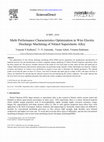
Materials Today: Proceedings, Elsevier , 2018
The optimization of wire electric discharge machining (Wire EDM) process parameters for simultane... more The optimization of wire electric discharge machining (Wire EDM) process parameters for simultaneous maximization of material removal rate and minimization of surface roughness during machining of Nitinol (Nickel-Titanium) superelastic alloy has been carried out. The process variables selected in this study are wire feed, pulse on time, pulse off time and spark gap set voltage. Multi performance characteristics optimization was performed using Taguchi's utility and Quality loss function. Analysis of means and analysis of variance were performed on signal to noise ratio to determine the optimal parameters. The optimal results reveal that the pulse on time of 115µsec, wire feed of 6m/min and spark gap set voltage of 40V with pulse off time of 25µsec are beneficial for maximizing the material removal rate and minimizing the surface roughness. The results indicate that the wire feed is the most significant parameter that affects the surface roughness and material removal rate.
Materials Today: Proceedings, Elsevier , 2018
Current global competitive environment demands high productivity. Lower productivity results in f... more Current global competitive environment demands high productivity. Lower productivity results in financial losses. Manufacturers strive to keep the productivity high. This study aims to determine the cycle time for coil winding and insertion processes and propose improved methods to reduce them and improve the productivity. The study also aims at studying the existing shop floor layout and propose revised layout to reduce material movement in the shop. Video work study is performed on existing and proposed methods and are compared to measure the improvements. Existing and proposed shop floor layouts were analyzed using string diagram technique and ARENA software.

IOP Conference Series: Materials Science and Engineering, 2019
The productivity of any manufacturing facility depends on how well various processes involved in ... more The productivity of any manufacturing facility depends on how well various processes involved in the plant are interconnected. Plant layout comprises of various departments and within these departments, there are different processes which are interdependent on each other. Proper design of plant layout combines all different workstations under single frame so as to enhance the productivity. But several small scale industries utilize the same old traditional layout which was framed during their establishment and therefore as they grow eventually over the years, due to change in market trends or to meet increasing customer demand redesigning of plant layout plays vital role. Analysis of existing plant layout helps in identifying loophole areas and explores measures to eliminate bottlenecks present. The main aim of this study is to find out most optimal way of arranging various workstations in the existing facility that will satisfy the present day demand from the customers which substantially increases the production rate. This study has been carried out at a tin container manufacturing industry named as LVT containers situated in Hubballi, Karnataka, INDIA. Analysis was conducted using the ARENA simulation software and the results obtained from simulation experiment were the basis for proposing potential changes in the existing plant layout.

IOP Conference Series: Materials Science and Engineering, 2019
NiTi(Nickel Titanium) Shape Memory Alloys (SMA) are expeditiously replacing conventional material... more NiTi(Nickel Titanium) Shape Memory Alloys (SMA) are expeditiously replacing conventional materials in aerospace, automobile, robotics and bio-engineering fields due to its distinctive characteristics like shape memory effect, pseudo elasticity and biocompatibility. Machining of these alloys is strenuous by traditional methods. The unconventional methods like wire electro discharge machining (WEDM) can competently machine these SMAs. But improper selection of WEDM parameters may lead to undesirable results such as poor surface finish and higher machining time. The present study attempts to explore the influence of three system variables; pulse on time, pulse off time and wire feed on performance criteria's like material removal rate (MRR) and surface roughness (SR) during WEDM of NiTi SMA. Experiments were conducted in accordance with Full Factorial Design (FFD) and results were analysed using Response surface methodology (RSM) based mathematical models. The investigation outcomes revealed that pulse on time has more influence on MRR and SR than pulse off time and wire feed. Maximum MRR is achieved at higher pulse on time with the combination of higher pulse off time and lower wire feed rate. Better surface finish is observed at decreased pulse on time, increased pulse off time and minimum wire feed rate.
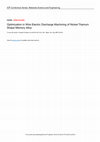
IOP Conference Series: Materials Science and Engineering, 2019
The present study focuses on optimizing the process parameters during machining of NiTi (Nickel-T... more The present study focuses on optimizing the process parameters during machining of NiTi (Nickel-Titanium) shape memory alloy by wire electric discharge machining (Wire EDM) for simultaneously maximizing material removal rate and minimizing tool wear rate u sing brass wire as electrode. Taguchi's design with utility and modified utility optimization techniques have been used for simultaneous multi-response optimization. Different analyses were performed to determine the optimal settings in both utility and mo dified utility concepts. The optimal results of both methods disclose that the pulse on time of 115µsec and pulse off time of 40µsec with spark gap set voltage of 20V are useful for maximizing material removal rate and minimizing tool wear rate. The optimization results indicate that the spark gap set voltage is the majority significant parameter that affects the tool wear rate and material removal rate.
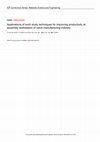
IOP Conference Series: Materials Science and Engineering, 2019
The work is carried to determine total cycle time to manufacture one gate valve assembly in valve... more The work is carried to determine total cycle time to manufacture one gate valve assembly in valve manufacturing industry. Improvement in productivity can be achieved through more efficient use of capital investments, human resource, technological innovation and developments. The goal was to improve the productivity through more efficient use of capital and human resource. Plant layout is the arrangement of machines on shop floor. This arrangement of machines will have impact on total cycle time to produce finished product. The present study explains about the productivity improvement in the plant layout of Micon valve manufacturing industries which is one of the reputed industries in Dharwad, India. Data was collected about existing plant layout and about chain of flow of product, man or machine with help of flow process chart. This flow process chart was used to establish layout from the point of improving layout and to identify/decide the locations of different workstations. The results obtained from this research work indicated that in proposed method there was reduction in total cycle time of 73 minutes and the total distance travelled by 130meters, which lead to increase in productivity at the assembly line of valve manufacturing industry.






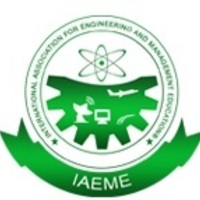

Uploads
Papers by Vinayak N Kulkarni
to develop their own experiments, instead of merely following the already set guidelines from a lab manual or elsewhere. Making labs open-ended pushes students to think for themselves and think harder. Outcome-based education is an educational theory that bases each part of an educational system around goals (outcomes). Outcome-based methods have been adopted in education systems around the world, at multiple levels. Measuring program-specific outcomes in engineering education is a challenge for teaching faculty in general and doing so for a laboratory program and through an open-ended experiment is even more challenging. This paper explains the planning and execution of open-ended experiment in Industrial Engineering and Simulation Laboratory and also it focuses on the evaluation process, rubrics developed, and attainment of program-specific outcome in Industrial and Production Engineering Program.
to develop their own experiments, instead of merely following the already set guidelines from a lab manual or elsewhere. Making labs open-ended pushes students to think for themselves and think harder. Outcome-based education is an educational theory that bases each part of an educational system around goals (outcomes). Outcome-based methods have been adopted in education systems around the world, at multiple levels. Measuring program-specific outcomes in engineering education is a challenge for teaching faculty in general and doing so for a laboratory program and through an open-ended experiment is even more challenging. This paper explains the planning and execution of open-ended experiment in Industrial Engineering and Simulation Laboratory and also it focuses on the evaluation process, rubrics developed, and attainment of program-specific outcome in Industrial and Production Engineering Program.